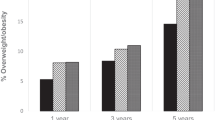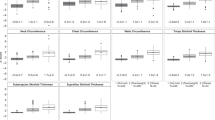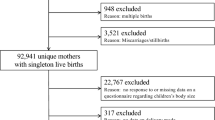Abstract
Background
Cesarean delivery has been linked with childhood obesity. Few studies have examined if this association is attenuated if there is labor prior to delivery. The objective of this current analysis was to examine the association of cesarean vs. vaginal delivery with measures of childhood adiposity, and whether the association differs by labor type (spontaneous, induced, or absent) preceding cesarean delivery.
Methods
We ascertained delivery mode and type of labor from medical records in 1443 mother–child dyads from Project Viva with adiposity measures from at least one follow-up visit (3369 total observations) in early childhood (median age 3.2 y), mid-childhood (median 7.7 y), or early teen (median 12.9 y). Child adiposity outcomes were CDC age- and sex-specific body mass index (BMI) z-scores, sum of subscapular and triceps skinfold thicknesses (SS + TR; mm), and waist circumference (cm). We used linear regression models with generalized estimating equation estimates and adjusted for maternal age, education, race/ethnicity, prepregnancy BMI, rate of gestational weight gain, and child sex and age at outcome.
Results
A total of 333 (23%) women delivered via cesarean, including 155 (11%) with spontaneous labor, 74 (5%) with induced labor, 99 (7%) with no labor, and 5 (<1%) with unknown labor status. Compared to vaginal-delivered children, cesarean-delivered children had higher BMI-z (0.15, 95% CI: 0.04, 0.26); and non-significantly higher waist circumference (0.50 cm, 95% CI: −0.34, 1.34) and SS + TR (0.47 mm, 95% CI: −0.52, 1.46). Cesarean deliveries that were preceded by spontaneous labor were not associated with childhood BMI-z (0.08, 95% CI: −0.07, 0.23), waist circumference (−0.12 cm, 95% CI: −1.09, 0.85), or SS + TR (−0.25 mm, 95% CI: −1.44, 0.93), as compared to vaginal deliveries.
Conclusion
Cesarean delivery was associated with higher childhood BMI-z, and although waist circumference and SS + TR trended in the same direction, these associations were not significant. Cesarean delivery preceded by spontaneous labor was not associated with adiposity outcomes.
This is a preview of subscription content, access via your institution
Access options
Subscribe to this journal
Receive 12 print issues and online access
$259.00 per year
only $21.58 per issue
Buy this article
- Purchase on Springer Link
- Instant access to full article PDF
Prices may be subject to local taxes which are calculated during checkout
Similar content being viewed by others
References
Boerma T, Ronsmans C, Melesse DY, Barros AJD, Barros FC, Juan L, et al. Global epidemiology of use of and disparities in caesarean sections. Lancet. 2018;392:1341–8.
Li HT, Zhou YB, Liu JM. The impact of cesarean section on offspring overweight and obesity: a systematic review and meta-analysis. Int J Obes. 2012;37:893.
Darmasseelane K, Hyde MJ, Santhakumaran S, Gale C, Modi N. Mode of delivery and offspring body mass index, overweight and obesity in adult life: a systematic review and meta-analysis. PloS One. 2014;9:e87896.
Kuhle S, Tong OS, Woolcott CG. Association between caesarean section and childhood obesity: a systematic review and meta-analysis. Obes Rev. 2015;16:295–303.
Mueller NT, Bakacs E, Combellick J, Grigoryan Z, Dominguez-Bello MG. The infant microbiome development: mom matters. Trends Mol Med. 2015;21:109–17.
Bager P, Wohlfahrt J, Westergaard T. Caesarean delivery and risk of atopy and allergic disesase: meta-analyses. Clin Exp Allergy. 2008;38:634–42.
Oken E, Baccarelli AA, Gold DR, Kleinman KP, Litonjua AA, De Meo D, et al. Cohort profile: project viva. Int J Epidemiol. 2015;44:37–48.
Kuczmarski RJ, Ogden CL, Guo SS, Grummer-Strawn LM, Flegal KM, Mei Z. et al. 2000 CDC growth charts for the UnitedStates: methods and development. Vital Health Stat. 2000;11:1–190.
Louer AL, Simon DN, Switkowski KM, Rifas-Shiman SL, Gillman MW, Oken E. Assessment of child anthropometry in a large epidemiologic study. J Vis Exp. 2017;120:54895.
Oken E, Kleinman KP, Rich-Edwards J, Gillman MW. A nearly continuous measure of birth weight for gestational age using a United States national reference. BMC Pediatr. 2003;3:6.
Breastfeeding and the use of human milk. Pediatrics. 2012;129:e827.
Perng W, Rifas-Shiman SL, Hivert MF, Chavarro JE, Oken E. Branched chain amino acids, androgen hormones, and metabolic risk across early adolescence: a prospective study in Project Viva. Obesity. 2018;26:916–26.
Martin JA, Hamilton BE, Osterman MJK, Driscoll AK. Births: final data for 2018. Natl Vital Stat Rep. 2019;68:1–47.
Huh SY, Rifas-Shiman SL, Zera CA, Edwards JWR, Oken E, Weiss ST, et al. Delivery by caesarean section and risk of obesity in preschool age children: a prospective cohort study. Arch Dis Child. 2012;97:610–6.
Mueller NT, Whyatt R, Hoepner L, Oberfield S, Dominguez-Bello MG, Widen EM, et al. Prenatal exposure to antibiotics, cesarean section and risk of childhood obesity. Int J Obes. 2014;39:665.
Yuan C, Gaskins AJ, Blaine AI, Zhang C, Gillman MW, Missmer SA, et al. Association between cesarean birth and risk of obesity in offspring in childhood, adolescence, and early adulthood. JAMA Pediatr. 2016;170:e162385–e162385.
Mueller NT, Zhang M, Hoyo C, Østbye T, Benjamin-Neelon SE. Does cesarean delivery impact infant weight gain and adiposity over the first year of life? Int J Obes. 2019;43:1549–55.
Li H, Ye R, Pei L, Ren A, Zheng X, Liu J. Caesarean delivery, caesarean delivery on maternal request and childhood overweight: a Chinese birth cohort study of 181 380 children. Pediatr Obes. 2014;9:10–16.
Rutayisire E, Wu X, Huang K, Tao S, Chen Y, Tao F. Cesarean section may increase the risk of both overweight and obesity in preschool children. BMC Pregnancy Childbirth. 2016;16:338.
Cai M, Loy SL, Tan KH, Godfrey KM, Gluckman PD, Chong Y-S, et al. Association of elective and emergency cesarean delivery with early childhood overweight at 12 months of age. JAMA Netw Open. 2018;1:e185025–e185025.
Rifas-Shiman SL, Gillman MW, Hawkins SS, Oken E, Taveras EM, Kleinman KP. Association of cesarean delivery with body mass index z score at age 5 years. JAMA Pediatr. 2018;172:777–9.
Pei Z, Heinrich J, Fuertes E, Flexeder C, Hoffmann B, Lehmann I, et al. Cesarean delivery and risk of childhood obesity. J Pediatr. 2014;164:1068–1073.e2.
Barros FC, Matijasevich A, Hallal PC, Horta BL, Barros AJ, Menezes AB, et al. Cesarean section and risk of obesity in childhood, adolescence, and early adulthood: evidence from 3 Brazilian birth cohorts. Am J Clin Nutr. 2012;95:465–70.
Carrillo-Larco RM, Miranda JJ, Bernabe-Ortiz A. Delivery by caesarean section and risk of childhood obesity: analysis of a Peruvian prospective cohort. PeerJ. 2015;3:e1046.
Chu DM, Ma J, Prince AL, Antony KM, Seferovic MD, Aagaard KM. Maturation of the infant microbiome community structure and function across multiple body sites and in relation to mode of delivery. Nat Med. 2017;23:314–26.
Reyman M, van Houten MA, van Baarle D, Bosch A, Man WH, Chu M, et al. Impact of delivery mode-associated gut microbiota dynamics on health in the first year of life. Nat Commun. 2019;10:4997.
Fouhy F, Watkins C, Hill CJ, O’Shea CA, Nagle B, Dempsey EM, et al. Perinatal factors affect the gut microbiota up to four years after birth. Nat Commun. 2019;10:1517.
Cox LM, Yamanishi S, Sohn J, Alekseyenko AV, Leung JM, Cho I, et al. Altering the intestinal microbiota during a critical developmental window has lasting metabolic consequences. Cell. 2014;158:705–21.
Whitt J, Woo V, Lee P, Moncivaiz J, Haberman Y, Denson L, et al. Disruption of epithelial HDAC3 in intestine prevents diet-induced obesity in mice. Gastroenterology. 2018;155:501–13.
Kozyrskyj AL, Kalu R, Koleva PT, Bridgman SL. Fetal programming of overweight through the microbiome: boys are disproportionately affected. J Dev Orig Health Dis. 2016;7:25–34.
Weger BD, Gobet C, Yeung J, Martin E, Jimenez S, Betrisey B, et al. The mouse microbiome is required for sex-specific diurnal rhythms of gene expression and metabolism. Cell Metab. 2019;29:362–382 e8.
Acknowledgements
Funding Grants from the US National Institutes of Health (R01 HD034568, R01 HD093761, UH3 OD023286, P30 DK046200). NTM is supported by the National Heart, Lung, and Blood Institute grant (K01HL141589).
Author information
Authors and Affiliations
Corresponding author
Ethics declarations
Conflict of interest
All authors declare no conflict of interest.
Additional information
Publisher’s note Springer Nature remains neutral with regard to jurisdictional claims in published maps and institutional affiliations.
Supplementary information
Rights and permissions
About this article
Cite this article
Mueller, N.T., Zhang, M., Rifas-Shiman, S.L. et al. Mode of delivery, type of labor, and measures of adiposity from childhood to teenage: Project Viva. Int J Obes 45, 36–44 (2021). https://doi.org/10.1038/s41366-020-00709-x
Received:
Revised:
Accepted:
Published:
Issue Date:
DOI: https://doi.org/10.1038/s41366-020-00709-x
This article is cited by
-
Pre-labor and post-labor cesarean delivery and early childhood adiposity in the Canadian Healthy Infant Longitudinal Development (CHILD) Cohort Study
International Journal of Obesity (2024)
-
The effect of environmental factors on precocious puberty in children: a case–control study
BMC Pediatrics (2023)
-
Cesarean delivery and metabolic health and inflammation biomarkers during mid-childhood and early adolescence
Pediatric Research (2022)
-
Are there adverse outcomes for child health and development following caesarean section delivery? Can we justify using elective caesarean section to prevent obstetric pelvic floor damage?
International Urogynecology Journal (2021)



